Did you know that those magazine photos of wolves in the wild usually aren’t taken in the wild? They’re not, because wolves can smell you a mile away and they want no part of you. Those photos are usually taken at a wolf preserve, like the Lakota Wolf Preserve in Columbia, NJ.
We stopped by there recently for a tour, chock full of interesting information not only about wolves, but bobcats and foxes, which they also have there. I thought the 1.5 hour tour might bore my 10 year old daughter, but she paid rapt attention, possibly because the caretakers told us interesting stories and facts about the animals, and she got to watch them being fed.
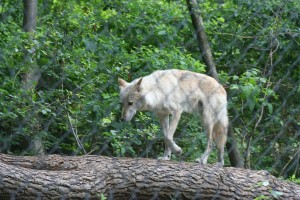
WOLVES
The preserve has 24 wolves, the most the government allows them to have on this size land (they’re on 10 acres, divided up into four compounds, by subspecies and pack). There are several reasons we got close-up views of the wolves. They’re not threatened by us here, and they have constant interaction with humans (the pups bond with the caretakers starting when they’re a month old). Plus, they’ll come to the fence when called by name, knowing that they’re going to get treats.
Some interesting facts about wolves:
-Wolves are endangered (you can’t take them out of the wild or put them into the wild).
-Wolves don’t normally attack humans (unless they have rabies). Our guide Jim said there is no documentation of an attack in the U.S., but some internet research says otherwise (albeit attacks are said to be rare).
-Wolves will raise pups that aren’t their own, but only if they come into the pack as pups.
-Wolves are hierarchical, with an alpha male and female, a beta (second in command), and omega (the weakest/shyest). The alphas eat first and are the only ones to mate. In order to guarantee all the wolves get fed, the preserve gives them frozen meat. That way the non-alphas can get their food while the alphas are eating their meat-pops.
-In order for the pups to poop, the mom licks the pup’s tush to stimulate the action. Without this, the pup will become constipated and die. Humans raising the pups must do something similar (using a warm washcloth). And when humans feed the pups with bottles, the bottles must be just the right temperature or the pups won’t eat.
-After the pups are weaned, they rely on regurgitated food initially.
-The wolves will eat an entire deer, except the jawbone and teeth – and it will take less than 30 minutes.
-Wolves are much more active in winter. In summer the heat makes them lazy.
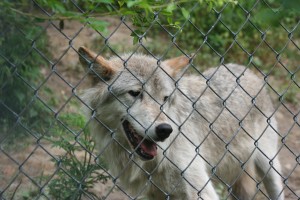
For photographers, you might be disappointed that the wolves are double-fenced, meaning that you’ll always have a chain-link fence in your shot. You can arrange a photo session (for $300). The money helps care for the animals, but you’ll also get between the fences, and they’ll unlock a window in that inner fence, allowing you to get an unencumbered shot (and they work with you to get the wolves in good position, by feeding them).
BOBCATS
The bobcats were adorable, but our guide said that they’re tigers stuffed in a cat’s body. The bobcats at this preserve were initially raised as household pets. In no uncertain terms, Pam discouraged anyone from trying to do this, saying that there’s no way to tame or domesticate a bobcat. A human trying to raise a bobcat does it a disservice, because the bobcat will have the natural bobcat instincts but not the learned skills from mom. The bobcat probably won’t have claws anymore either, which doesn’t help the cat when humans realize they’re ill-equipped to continue raising it as an adult. The cat can’t survive then in the wild.
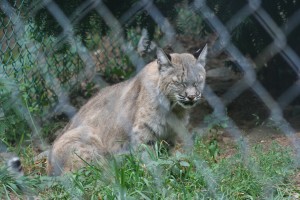
Some interesting facts about bobcats:
-Most bobcats are solitary creatures and want their own territory, but the preserve has 2 bobcats that live together.
-If hungry or bored, a bobcat can kill a rattlesnake
-A bobcat can kill a deer, by jumping onto its back and wearing down the buck with its teeth and claws.
-Male bobcats will sometimes go after the babies. Mama bobcats will defend visciously
-Mama bobcats signal their babies about danger, by twitching their ears closely and quickly, so it looks like flashing lights (the back of the ear tips are white).
-Bobcats have very sensitive hairs in their ears which can sense ground vibrations.
FOXES
The preserve has several red foxes on site. Though they’re the red species, they don’t necessarily have red coats. Look for a white tip on the tail to know if it’s a red fox. One of their foxes is black, one is blonde, but turns silver in winter.
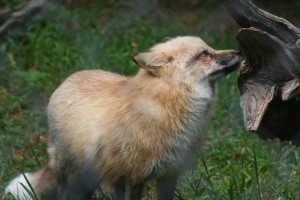
Interesting facts about foxes:
-Though they have a reputation for only coming out at night (unless they’re sick), they’ll now sometimes come out during the day if healthy, to look for food. We’re encroaching on their habitat.
-Foxes can run up to 45 mph for short distances.
-Foxes sound like monkeys. And sometimes like a woman screaming.
-Female foxes choose her mate (and may have more than one). She picks which male will help her raise the pups, and he’ll babysit and bring food.
-Foxes can live on their own after 3 months (though usually leave mom around 4-5 months). At 9 months the fox will mate.
-Foxes are social and will stir up trouble, especially with animals they consider aggressive. Like maybe teasing a chained-up dog.
-Foxes like to play with kids’ toys. And trampolines.
-Foxes are in the canine family, but can’t successfully mate with dogs.
IF YOU GO
Where: The Lakota Wolf Preserve is in Columbia, NJ. The preserve is on 10 acres in the Camp Taylor Campground, which looked like a fun place to stay (they have cute cabins in addition to tent and RV sites. They have a lake for swimming and fishing, and hiking trails as well.
When: They have two “wolf watches” daily (except Monday), at 10:30 and 3:00 (though you need to arrive earlier to register). They can handle a lot of people, so don’t worry about missing out on a tour because of that.
Reservations: No reservations are needed Saturdays or Sundays. You do need to call about weekday (Tuesday-Friday) tours because of school groups. They’re closed Mondays. Call in winter to see if they’re open that day. Call 908-496-9244.
Cost: $16.05/adult (ages 12+), $7.49/kids (ages 2-11). No credit cards allowed (cash or checks only).
Ages: any age is welcome.
Other: The walk to the watch area is about 15 minutes, rocky and uphill. They do offer a free bus ride as well. We walked, and saw some deer along the way. You can bring a stroller on the tour – the area is pretty flat.
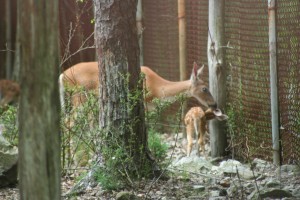
Like this? Like Jersey Kids on Facebook and subscribe to get an email of every new post.

One Reply to “Lakota Wolf Preserve – With Kids”
Comments are closed.